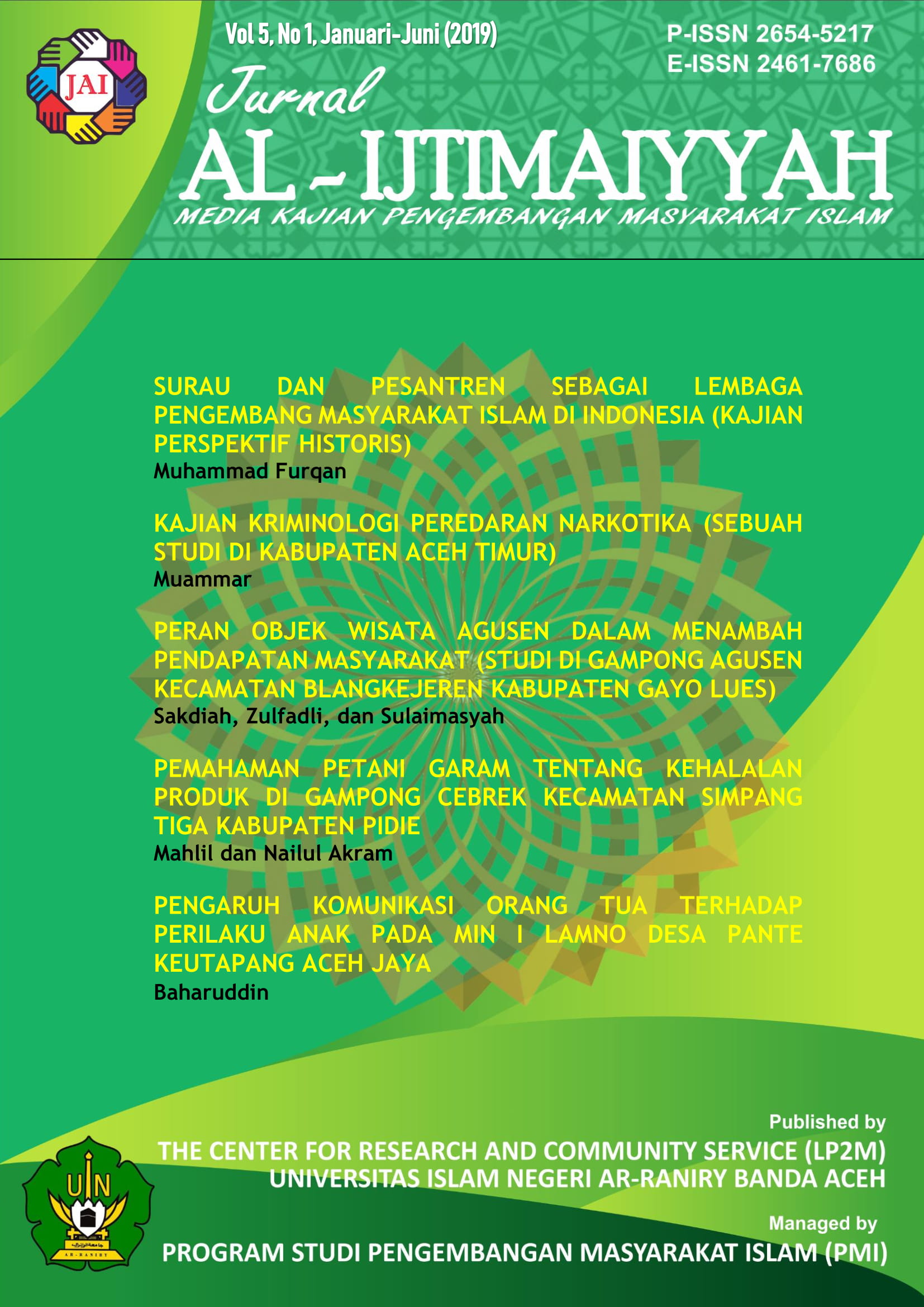KAJIAN KRIMINOLOGI PEREDARAN NARKOTIKA (SEBUAH STUDI DI KABUPATEN ACEH TIMUR)
DOI:
https://doi.org/10.22373/al-ijtimaiyyah.v5i1.5133Abstract
The impact of globalization has penetrated throughout the civilization of the nations of the world, running so fast. Especially very influential on changes in various lines of life. Related to this is the issue of increasing narcotics abuse and narcotics illicit trafficking which has created conditions that have hindered the development process and weakened civilization. Eradication of narcotics distribution is a national problem, because it has a negative impact that can damage and threaten the lives of the people, nation and state and can hamper the national development process. The rise of narcotics abuse does not only occur in big cities, but has reached small cities in all ten regions of the Republic of Indonesia, including East Aceh Regency. The increasingly diverse lifestyle of the people due to the influence of globalization also contributes to the increasing circulation of narcotics in East Aceh District. This certainly must receive serious attention, because if we look at what is happening in East Aceh District and several other regions in Indonesia, the crime of narcotics distribution from time to time always increases which in the end is increasingly unsettling the community, so before these things increase In East Aceh District, an effective solution must be found to eradicate it. Factors that cause a person to commit a narcotics crime in East Aceh Regency are due to economic factors where a person needs money to live and the difficulty of getting work, family environmental factors, social environmental factors and availability / lack of supervision factors. Efforts in tackling narcotics circulation in East Aceh district involve many parties, including: firstly, pre-emptive efforts by providing counseling in the community and schools about narcotics carried out by the police in tackling narcotics crime in East Aceh District. Second, preventive measures (prevention) by conducting raids and patrols routinely, providing oversight of the association and positive activities carried out by the police, prosecutors, religious leaders, community leaders and youth organizations. The third repressive effort (action) which aims to provide a deterrent effect on the perpetrators of drug trafficking crimes involving all law enforcement officials ranging from the Police, Attorney and District Courts and Detention Houses.
Keywords: Crimonology, Narcotics Circulation.
References
A. Kadarmanta. 2010. Narkoba Pembunuh Karakter Bangsa. Jakarta: Media Utama.
Amiruddin dan Zainal Asikin. 2013. Pengantar Metode Penelitian Hukum. Jakarta: Rajawali Pers.
Barda Nawawi Arif. 2011. Bunga Rampai Kebijakan Hukum Pidana (Perkembangan Penyusunan Konsep KUHP Baru). Jakarta: Kencana.
Frank E. Hagan. 2013. Pengantar Kriminologi Teori Metode dan Perilaku Kriminal. Jakarta: Pranadamedia.
Ida Hanifah, dkk. 2014. Pedoman Penulisan Skripsi. Medan: Fakultas Hukum Universitas Muhammadiyah Sumatera Utara.
J. Robert Lilly, dkk. 2015. Teori Kriminologi Konteks dan Konsekuensi. Jakarta: Pranada Media.
Kristian. 2016. Kejahatan Korporasi di Era Modern dan Sistem Pertanggungjawaban Pidana Korporasi. Jakarta: Refika Aditama.
Moh. Taufik Makaro. 2005. Tindak Pidana Narkotika. Jakarta: Ghalia Indonesia.
Romli Atmasasmita. 2013. Teori dan Kapita Selekta Kriminologi. Jakarta: Eresco.
Siswanto Sunarto. 2011. Penegakan Hukum Psikotropika Dalam Kajian Sosiologi Hukum. Jakarta: Rajawali Pers.
Topo Santoso dan Eva Achjani. 2015. Kriminologi. Jakarta: Rajawali Pers.
Undang-Undang Nomor 35 Tahun 2009 Tentang Narkotika.
Undang-Undang Nomor 22 Tahun 1997 Tentang Narkotika.
W. A. Bonger. 2015. Pengantar Tentang Kriminologi. Jakarta: Pustaka Sarjana.
Yesmil Anwar dan Adang. 2013. Kriminologi. Bandung: Refika Aditama.
www.academia.edu.com
www.mardanijaya. blogspot.co.id
www.aceh.tribunnews.com
www.komunitastebe.blogspot.co.id
www.repository.unhas.ac.id
Downloads
Published
Issue
Section
License
Authors who publish in Jurnal Al-Ijtimaiyyah agree to the following terms:
- Authors retain copyright and grant the journal right of first publication with the work simultaneously licensed Attribution-ShareAlike 4.0 International (CC BY-SA 4.0) that allows others to share the work with an acknowledgment of the work's authorship and initial publication in this journal.
- Authors are able to enter into separate, additional contractual arrangements for the non-exclusive distribution of the journal's published version of the work (e.g., post it to an institutional repository or publish it in a book), with an acknowledgment of its initial publication in this journal.
- Authors are permitted and encouraged to post their work online (e.g., in institutional repositories or on their website) prior to and during the submission process, as it can lead to productive exchanges, as well as earlier and greater citation of published work. (See The Effect of Open Acces)











